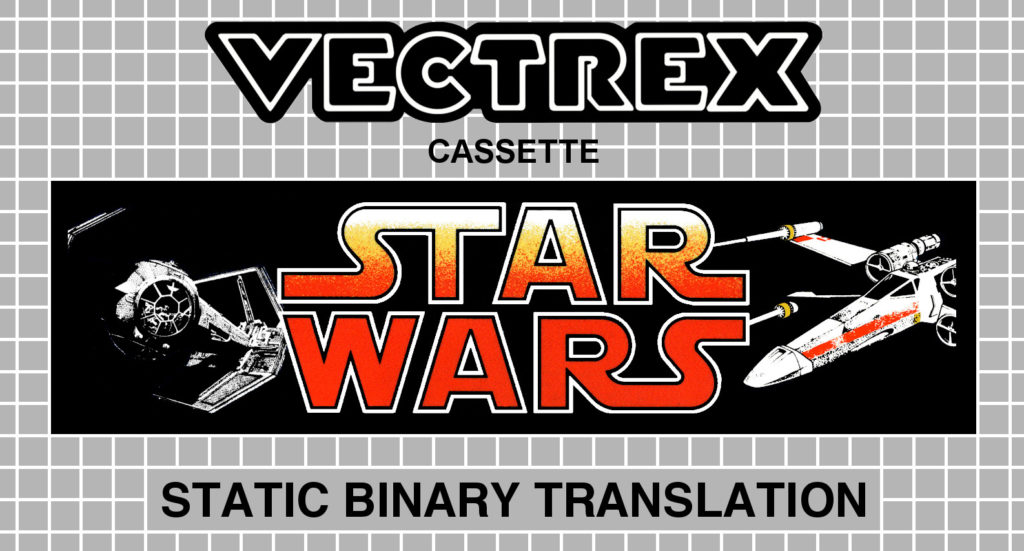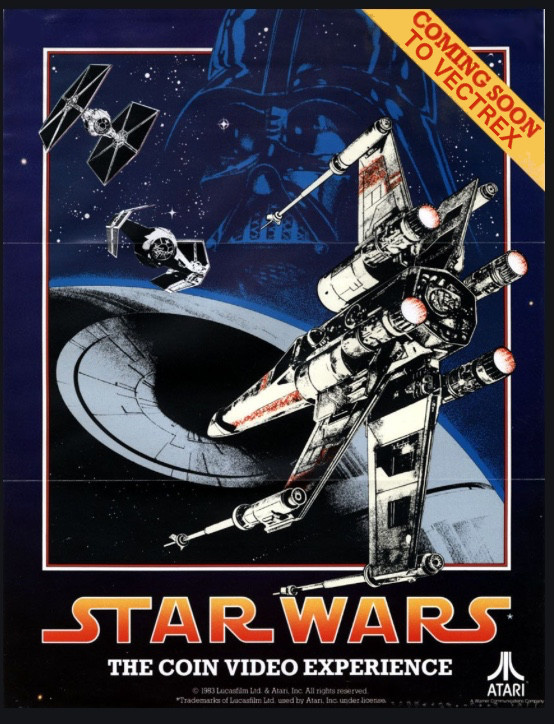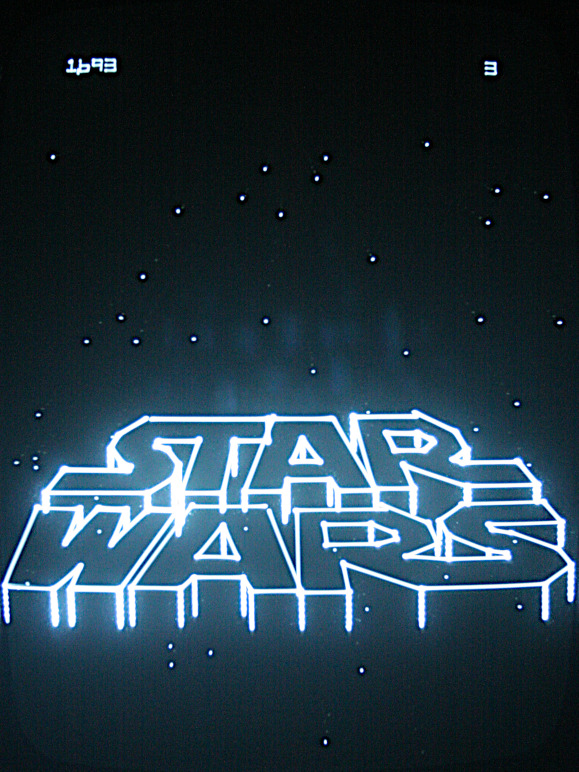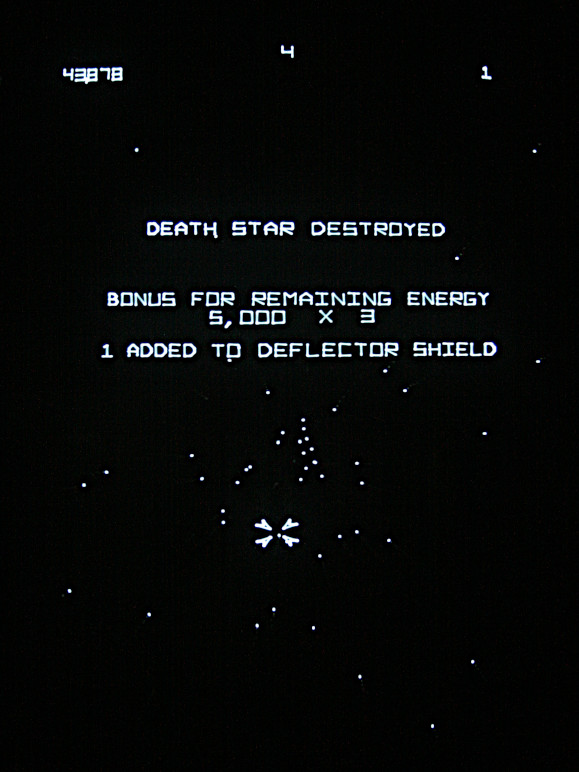VecFever documentation
Star Wars

Atari, 1983
Atari’s Star Wars is an excellent vector game and was the ideal motivation to develop translation tools for the 6809 CPU – the one used by Star Wars and incidentally also the Vectrex – to be able to play this via the VecFever. I knew from the outset that this arcade game was a challenge: the original hardware has great sound -voice output and sixteen (count them: sixteen !) channels via a quad-pokey. And the arcade vector count is very high, too high for the Vectrex for a stable refresh, but was confident that with a bit of management (read: removing vectors whenever possible and heavily adapting the sound code) this should work well. And with a bit further digging into the original code the usual ‘convert a horizontal game into a vertical one’ trick should work very well, too, this being a 3D game after all. And it did.
To have the best experience the game allows four different graphics outputs – the original arcade output, the fastest Vectrex output plus two more Vectrex variants which includes the full shield graphics (instead of just a no. for the shield strength) plus the whole overlay including the X-Wing. The reason for three Vectrex outputs is not only that personal preferences differ but also for overlays where esp. the X-Wing can be printed on and so should not be output.
Besides the really nice Vectrex portrait mode I myself am also very pleased with the brightness effects: Star Wars uses a neat trick deliberately drawing lines at the sides of the tube outside of the visible screen to lighten up the entire screen when you are hit and this works very well on the Vectrex, too. But to me the bright, incoming enemy shots are really something, they look like huge plasma balls when fired off; even brighter than Asteroids shots.
Hard to take a photo of but I think these do get this effect across:
So I can recommend playing this game on the Vectrex – it is simply fun.

Options
- Bonus Shields: 0/1/2/3
- Difficulty: Easy/Moderate/Hard/Hardest
- Game Info
- Graphics: Arcade/Vectrex/Vectrex+Shield/Vectrex+XWING
- Joystick: Normal/Y-Inverted
- Reset Highscores (the game stores the first three entries)
- Starting Shields: 6/7/8/9
Localization
//NAME="STARWARS"
//
GERMAN[] = {
{ 0, 0, "Startschilde"},
{ 0, 0, "Bonusschilde"},
{ 0, 0, 0},
{ 0, 0, "Vectrex+Schild"},
{ 0, 0, 0},
{ 0, 0, "Joystick: Y-Invertiert"},
{ 0, 0, " Star Wars, das Farbvektorspiel von Atari, ist nicht nur durch das Thema sehr interessant sondern auch vom technischen Standpunkt her: obwohl eine andere CPU benutzt wird (6809 wie in der Vectrex), eine 'Mathebox' und zusätzliche Sound- und Sprachhardware ist es trotzdem deutlich ein Kind meines Allzeitlieblinges Asteroids. Der grundsätzliche Aufbau - eine 8-Bit CPU und als Herz ein Interrupthandler welche einen Atari Vektorprozessor füttert - mit einigen darauf basierenden Desingentscheidungen sind identisch. Star Wars ist wirklich Ataris Zenit der 8-bit Vektorentwicklung angefangen mit Lunar Lander. Es ist ebenfalls sehr sauber programmiert, ein netter Bonus und definitiv nicht immer der Fall. Ein weiteres, einzigartiges Feature des Spiels ist es den ganzen Schirm aufzuhellen, wenn man getroffen wird, indem es gewollt ausserhalb des sichtbaren Schirms auf die Seiten der Röhre zeichnet. Was auch für die Vectrex übernommen wurde hier... "}
};
FRENCH[] = {
{ 0, 0, "Mise en Place des Boucliers"},
{ 0, 0, "Boucliers Bonus"},
{ 0, 0, 0},
{ 0, 0, "Vectrex+Visualisation du Bouclier"},
{ 0, 0, 0},
{ 0, 0, "Joystick: Y-Inversé"},
{ 0, 0, " Star Wars, le jeu d'arcade vectoriel en couleur d'Atari, est de toute évidence génial en raison du thème (La Guerre des Etoiles) mais il est également intéressant d'un point de vue technique : même s'il utilise un autre processeur, une nouvelle 'mathbox', une table d'harmonie supplémentaire et la parole, il reste clairement le descendant direct de mon jeu préféré de toujours: Asteroids. En effet la configuration de base (un processeur 8 bits utilisant un gestionnaire d'interruptions principal qui alimente un processeur vectoriel Atari ) et plusieurs décisions de conception logicielle reposant sur celle-ci, sont ici identiques. A mon avis, l'apogée du développement de la technologie des vecteurs 8 bits a commencé avec Lunar Lander. Pour autant, Star Wars est aussi programmé de manière très propre, et c'est un plus incontestable, car ce n'est vraiment pas toujours le cas. Une autre caractéristique unique de ce jeu est qu'il dessine délibérément des vecteurs brillants hors du champ visuel lorsqu'on est touché, ce qui a pour effet d'éclairer l'écran. "}
};
ENGLISH[] = {
{ 0, 0, "Starting Shields"},
{ 0, 0, "Bonus Shields"},
{ 0, 0, "Vectrex+XWING"},
{ 0, 0, "Vectrex+Shield"},
{ 0, 0, "Joystick: Normal"},
{ 0, 0, "Joystick: Y-Inverted"},
{ 0, 0, " Star Wars, the color vector arcade game by Atari, is obviously great due to the theme but it is also interesting from a technical standpoint: even though it uses another CPU, new mathbox, additional soundboard and speech it is still clearly a child of my all-time favorite - Asteroids. The basic setup - an 8-bit cpu using a master interrupt handler which feeds an Atari vector processor - with several software design decisions hinging on this premise are identical. In my mind the pinnacle of the 8-bit vector technology development started with Lunar Lander. It is also very cleanly programmed, a real bonus and definitely not always the case. Another unique feature is that it deliberately draws bright vectors out of bounds when being hit to lighten up the screen. "}
};







